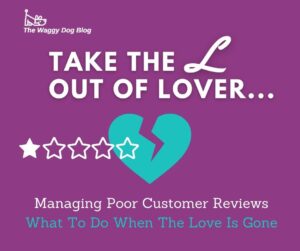What To Do When The Love Is Gone
 FEBRUARY is typically the month of love. But what do you do when your customer leaves you a poor review online? Is it over for good? Not necessarily.
FEBRUARY is typically the month of love. But what do you do when your customer leaves you a poor review online? Is it over for good? Not necessarily.
Online Reviews – The Good, The Bad and The Ugly
Managed correctly, customer reviews on Google and Facebook can be one of your most valuable marketing tools. They engender trust in your services, create a buzz around your brand and best of all, they don’t cost anything. However, as powerful as a 5-star review can be, a poor review can be equally damaging. Online reviews can’t be deleted, so the way you respond publicly will determine how much harm is done to your practice’s reputation.
How Customers Are Perceiving Poor Reviews
The veterinary industry has always been emotionally charged, and challenges imposed by the pandemic and staff shortages have only exacerbated the problem. Thankfully, most people with any commonsense will be able to spot a baseless complaint from a mile away – especially when they include vague criticisms and accusations without mentioning any specific facts. Customer behaviour has deteriorated significantly in recent years, both in person and online. So much so, that many of our good customers are starting to become more cynical and less tolerant of tantrums levelled at overworked vets and nurses. I’ve often found that when a disgruntled customer posts a nasty comment on a Facebook post, others are quick to jump to the defence of the vet practice. They’ve had enough!

Of course not all poor reviews are retaliatory. There ARE going to be genuine complaints, so you should see these as an opportunity to improve your business reputation.
- Monitor your Google reviews and Facebook recommendations regularly. You should be receiving notifications on email every time a new review is posted. There’s nothing worse than a bad review with no reply from the business owner. It sends a message that the complaint is not important to you.
- Thank the customer for taking the time to leave you a review. Yes – even the bad ones!
- Apologise for the fact that they’ve had a disappointing experience. You’re not admitting fault, but you’re showing empathy.
- Invite the customer to take the conversation offline. Remember – this is a public forum. Offer to give them a call so that you can address their complaint privately.
- Aim to find a solution. At this stage, you’ll find that customers without a genuine complaint will often back down. Poor reviews are often posted after a miscommunication. Those with a genuine grievance will want to know that you are listening to them and that you want to address their concerns about their pet.
- Ask them if they will amend or delete their poor review. When you have resolved a complaint or misunderstanding, the client may even apologise. They might feel embarrassed about posting a bad review in the heat of the moment and offer to remove it. Demonstrate your understanding. Let them know that you would be grateful if they deleted their review and then reassure them that you want to help with their pet’s health issues.
- Stand your ground. If the review is abusive you are within your rights to defend your practice and to refuse them service. Reply assertively, state the facts and maintain your professionalism.




